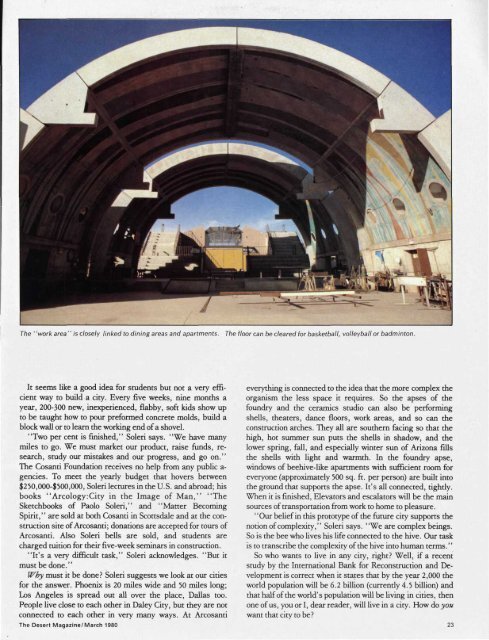BYWAYS PLUS: DATES! - Desert Magazine of the Southwest
BYWAYS PLUS: DATES! - Desert Magazine of the Southwest
BYWAYS PLUS: DATES! - Desert Magazine of the Southwest
Create successful ePaper yourself
Turn your PDF publications into a flip-book with our unique Google optimized e-Paper software.
The "work area" is closely linked to dining areas and apartments. The floor can be cleared for basketball, volleyball or badminton.<br />
It seems like a good idea for students but not a very efficient<br />
way to build a city. Every five weeks, nine months a<br />
year, 200-300 new, inexperienced, flabby, s<strong>of</strong>t kids show up<br />
to be taught how to pour preformed concrete molds, build a<br />
block wall or to learn <strong>the</strong> working end <strong>of</strong> a shovel.<br />
"Two per cent is finished," Soleri says. "We have many<br />
miles to go. We must market our product, raise funds, research,<br />
study our mistakes and our progress, and go on."<br />
The Cosanti Foundation receives no help from any public agencies.<br />
To meet <strong>the</strong> yearly budget that hovers between<br />
$25O,OOO-$5OO,OOO, Soleri lectures in <strong>the</strong> U.S. and abroad; his<br />
books "Arcology:City in <strong>the</strong> Image <strong>of</strong> Man," "The<br />
Sketchbooks <strong>of</strong> Paolo Soleri," and "Matter Becoming<br />
Spirit," are sold at both Cosanti in Scottsdale and at <strong>the</strong> construction<br />
site <strong>of</strong> Arcosanti; donations are accepted for tours <strong>of</strong><br />
Arcosanti. Also Soleri bells are sold, and students are<br />
charged tuition for <strong>the</strong>ir five-week seminars in construction.<br />
"It's a very difficult task," Soleri acknowledges. "But it<br />
must be done."<br />
Why must it be done? Soleri suggests we look at our cities<br />
for <strong>the</strong> answer. Phoenix is 20 miles wide and 50 miles long;<br />
Los Angeles is spread out all over <strong>the</strong> place, Dallas too.<br />
People live close to each o<strong>the</strong>r in Daley City, but <strong>the</strong>y are not<br />
connected to each o<strong>the</strong>r in very many ways. At Arcosanti<br />
The <strong>Desert</strong> <strong>Magazine</strong>/March 1980<br />
everything is connected to <strong>the</strong> idea that <strong>the</strong> more complex <strong>the</strong><br />
organism <strong>the</strong> less space it requires. So <strong>the</strong> apses <strong>of</strong> <strong>the</strong><br />
foundry and <strong>the</strong> ceramics studio can also be performing<br />
shells, <strong>the</strong>aters, dance floors, work areas, and so can <strong>the</strong><br />
construction arches. They all are sou<strong>the</strong>rn facing so that <strong>the</strong><br />
high, hot summer sun puts <strong>the</strong> shells in shadow, and <strong>the</strong><br />
lower spring, fall, and especially winter sun <strong>of</strong> Arizona fills<br />
<strong>the</strong> shells with light and warmth. In <strong>the</strong> foundry apse,<br />
windows <strong>of</strong> beehive-like apartments with sufficient room for<br />
everyone (approximately 500 sq. ft. per person) are built into<br />
<strong>the</strong> ground that supports <strong>the</strong> apse. It's all connected, tightly.<br />
When it is finished, Elevators and escalators will be <strong>the</strong> main<br />
sources <strong>of</strong> transportation from work to home to pleasure.<br />
' 'Our belief in this prototype <strong>of</strong> <strong>the</strong> future city supports <strong>the</strong><br />
notion <strong>of</strong> complexity," Soleri says. "We are complex beings.<br />
So is <strong>the</strong> bee who lives his life connected to <strong>the</strong> hive. Our task<br />
is to transcribe <strong>the</strong> complexity <strong>of</strong> <strong>the</strong> hive into human terms.''<br />
So who wants to live in any city, right? Well, if a recent<br />
study by <strong>the</strong> International Bank for Reconstruction and Development<br />
is correct when it states that by <strong>the</strong> year 2,000 <strong>the</strong><br />
world population will be 6.2 billion (currently 4.5 billion) and<br />
that half <strong>of</strong> <strong>the</strong> world's population will be living in cities, <strong>the</strong>n<br />
one <strong>of</strong> us, you or I, dear reader, will live in a city. How do you<br />
want that city to be?<br />
23
















